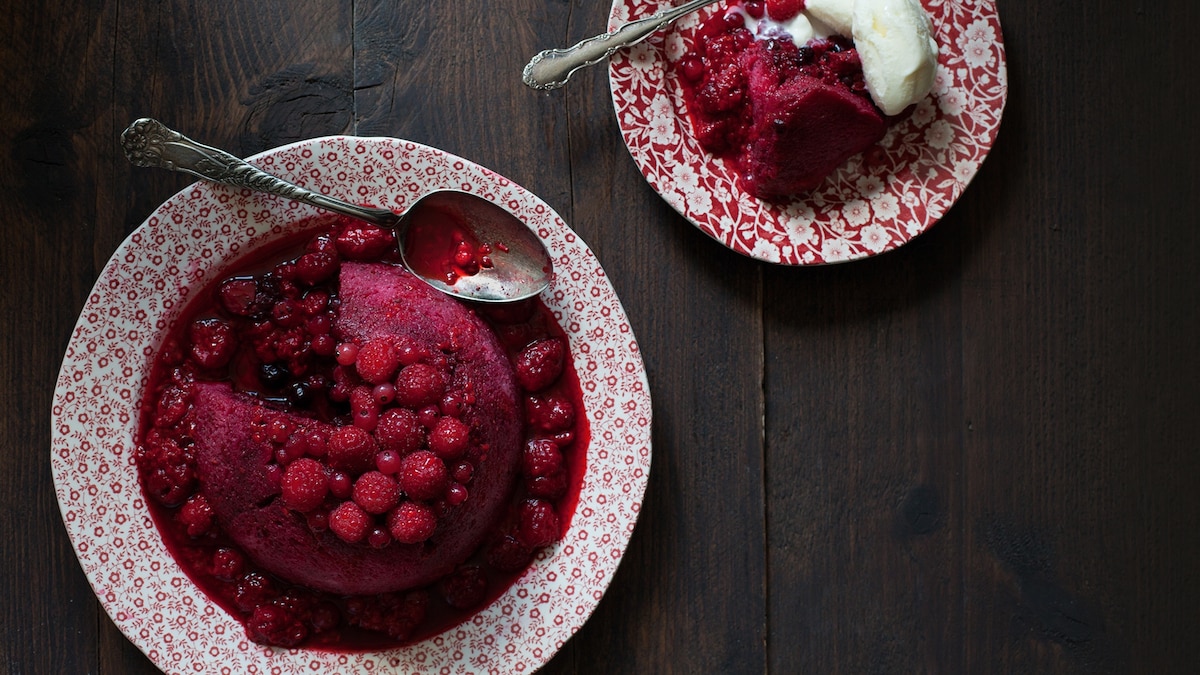This article was produced by National Geographic Traveller (UK).
This dessert was all the rage in English health spas during the 19th century, when it was known as ‘hydropathic pudding’. Its light casing of white bread meant it was considered a ‘healthy’ treat by the Victorians.
Preparation
To help with de-moulding, line your basin with cling film; leave enough overhanging to cover the top. To fit your bread into a classic pudding basin, cut it into trapezium shapes; if you use a cake tin you can cut it into rectangles.
Bread
Use the best-quality white bread you can, or a homemade loaf. Factory-made bread will turn slimy because of the additives and your pudding will almost certainly be unable to hold its shape.
Filling
A medley of raspberries, blackberries, redcurrants and blueberries works well, while strawberries tend to go soggy. Whether you use fresh or frozen fruit, only cook it until the sugar dissolves so the berries keep their structure.
Resting
Once you’ve made your pudding, refrigerate it overnight, weighed down with a plate and a tin of something on top, so that it sits snug. Resting allows the bread to soak up the juices, turning the whole thing a deep pink colour.
Serving
When you’re ready to serve, open up the cling film, place a rimmed serving plate on top of the mould and invert. Serve with vanilla ice cream or clotted cream (or another thick cream) for indulgence, or skyr for a healthier alternative.
Recipe: Regula Ysewijn’s summer pudding
Takes: 15 mins, plus overnight chilling
Serves: 8
Ingredients
Butter, for greasing
650g raspberries
150g blackberries
100g redcurrants or blueberries (alternatively, use frozen mixed berries)
50g raw sugar
1 loaf of plain white bread
Method
1. Lightly grease a 17cm pudding basin (or rectangular cake tin, if you prefer) and line with cling film. Leave enough cling film overhanging the edges of the basin to cover the pudding.
2. Toss all the berries in a saucepan and heat gently with the sugar to get the crimson juices running and the sugar to dissolve, no longer than 2-3 mins (if using frozen berries, which is fine and far more economical, do the same). Let the berries cool in the pan.
3. Cut the bread into 1cm-thick slices, removing the crust. Cut a round out of one slice to fit the bottom of the pudding basin. Trim the rest of the slices into a slight trapezium shape to fit the sloping edges of the bowl (if your bowl is straight, or you’re using a cake tin or charlotte mould, you don’t need to fuss with cutting shapes — but you do still need to remove the crust).
4. Line the basin with the bread, ensuring there are no gaps for the filling to leak through. Spoon the cooled berries into the bread-lined basin, reserving as much of the juice in the saucepan as you can manage.
5. Cover with another slice, or slices, of bread and pour over enough of the reserved juice for it to be nicely covered. Reserve the remaining juice for serving.
6. Cover the pudding with the overhanging cling film, then place a plate or a lid on top and add a weight (a tin of tomatoes works well).
7. Put in the fridge overnight to allow the bread to soak up the juices. When ready to serve, unwrap the clingfilm, place a plate on top of the basin and invert. Serve the summer pudding with vanilla ice cream, clotted cream or thick cream, or with thick yoghurt for a lighter option.
Taken from Pride and Pudding, by Regula Ysewijn (£30, Murdoch Books).
To subscribe to National Geographic Traveller (UK) magazine click here. (Available in select countries only).
